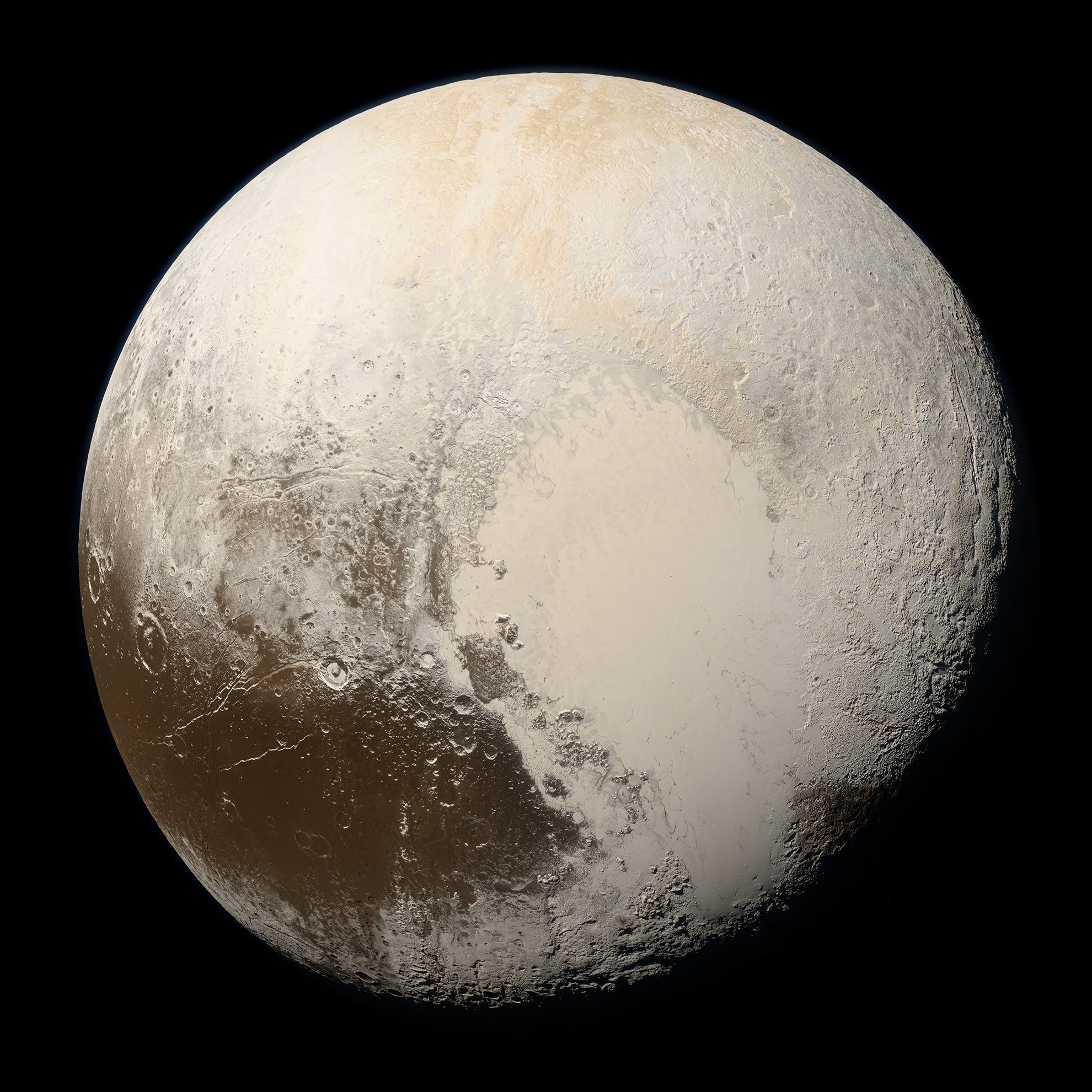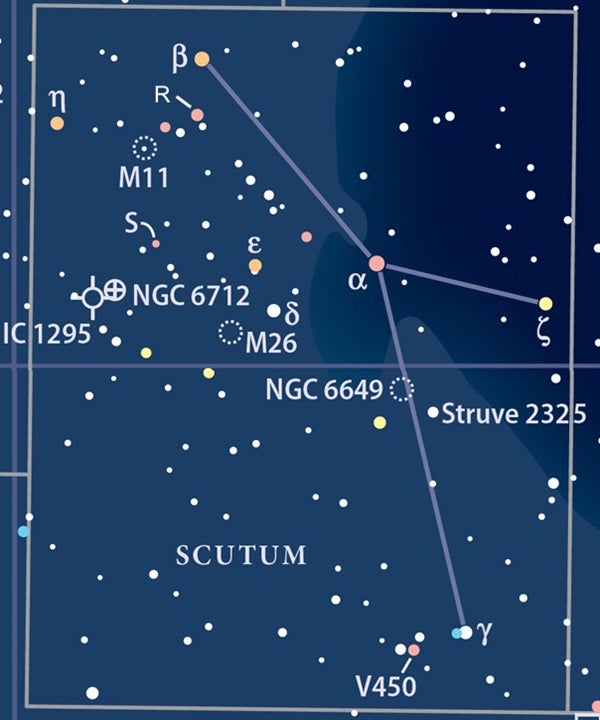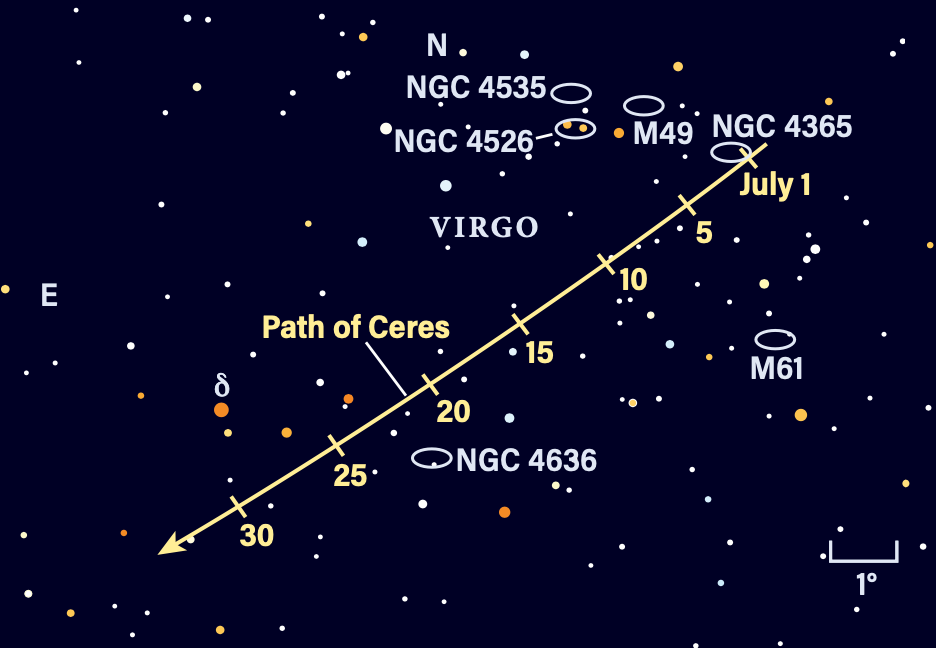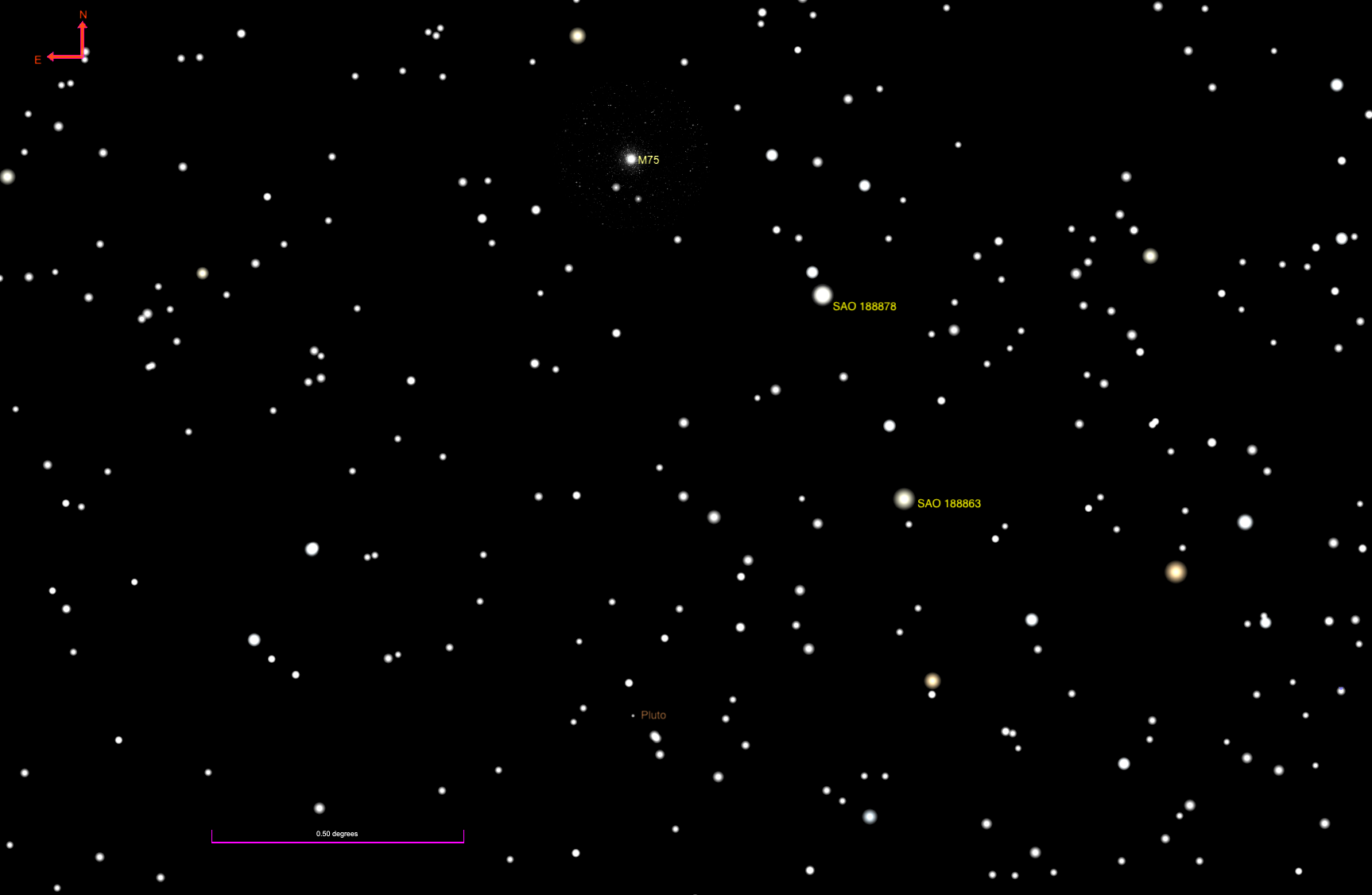
Friday, July 14
Saturn’s biggest and brightest moon, Titan, skims south the planet overnight tonight. At magnitude 8.5, it outshines any fellow moons by roughly 1.5 magnitudes.
Saturn rises relatively late; by 11:30 P.M., it is some 10° above the eastern horizon. It will continue to climb overnight, so catching it even later or early into the morning of the 15th will further boost the view. The ringed planet shines at magnitude 0.6, standing out against the relatively sparse stars of Aquarius. Zoom in on it with a telescope for a stunning view of the 18″-wide disk surrounded by 42″-wide rings, tilted toward us by nearly 8°.
Titan lies 25″ south of the center of the planet’s disk. Overnight, it moves from southeast to southwest, depending on what time you catch it. Several smaller, fainter moons lie in the equatorial plane of the planet: Dione to the west and Tethys (closer) and Rhea to the east. You may be able to catch even more, fainter moons if you have a large scope and good seeing, particularly early tomorrow morning when Saturn has risen even higher. Mimas sits just southwest of Saturn’s disk, close to the rings, while Enceladus lies between Tethys and the eastern tip of the rings.
Sunrise: 5:43 A.M.
Sunset: 8:28 P.M.
Moonrise: 2:41 A.M.
Moonset: 6:29 P.M.
Moon Phase: Waning crescent (9%)
*Times for sunrise, sunset, moonrise, and moonset are given in local time from 40° N 90° W. The Moon’s illumination is given at 12 P.M. local time from the same location.
Saturday, July 15
Two hours after the Sun disappears, the sky is dark and Cygnus the Swan is already 50° high in the east. Tonight, we’re going to try for the North America Nebula (NGC 7000). It lies about 3° east of the bright star Deneb, which marks the Swan’s tail (and is one point of the Summer Triangle asterism).
NGC 7000 spans an impressive 2° at its widest and covers an area some 10 times that of the Full Moon. It is best seen with a wide-angle eyepiece to capture its full extent; drop in an OIII or UHC filter to better bring out the nebula’s soft glow. Like its namesake, it is shaped roughly like the continent of North America, situated north-south. Can you see the likeness, particularly along the eastern and southern coastlines?
This emission nebula is composed of hot, glowing gas energized not by Deneb, but by the much closer, much hotter J205551.3+435225, an O-type star that lies between the North America Nebula and the smaller Pelican Nebula to its southeast. The Pelican sits on the other side of the dark, dusty patch that defines NGC 7000’s eastern “coastline” so well — a wide field of view will capture both at once.
Sunrise: 5:44 A.M.
Sunset: 8:28 P.M.
Moonrise: 3:26 A.M.
Moonset: 7:27 P.M.
Moon Phase: Waning crescent (4%)

Sunday, July 16
Look southeast after dark tonight and you should immediately spot the bright star Altair in Aquila, which anchors another point of the Summer Triangle (along with Deneb, from last night, and Vega in Lyra). Scan about 25° southwest of Altair to cross from Aquila into the small constellation Scutum the Shield, where our target is the famous variable star R Scuti.
This star was one of the first variables ever discovered. You’ll find it about 1° south-southeast of magnitude 4.2 Beta (β) Scuti in northern Scutum. Averaging a magnitude around 5.2, R Scuti can shine as brightly as magnitude 4.5 or fade completely out of sight down to magnitude 8.2, depending on where it is in its brightness cycle, which lasts 144 days.
Although Scutum is a small constellation, it lies near the plane of the Milky Way and contains several deep-sky objects in addition to its scattering of bright stars. One such target, the Wild Duck Cluster (M11), is just 1° southeast of R Scuti. M11 is a bright, loose open cluster of young stars that shines at roughly 6th magnitude. It’s a great object particularly for binoculars and small scopes, spreading across about 14′ on the sky and containing hundreds of stars.
Another smaller, fainter open cluster, M26, is also nearby. You’ll find it 3.5° south-southwest of M11, shining around 8th magnitude and covering a similar span on the sky. This cluster only contains about 100 stars, so it’s not as rich but still offers a nice contrast with the appearance of M11.
Sunrise: 5:45 A.M.
Sunset: 8:27 P.M.
Moonrise: 4:17 A.M.
Moonset: 8:16 P.M.
Moon Phase: Waning crescent (1%)
Monday, July 17
New Moon occurs at 2:23 P.M. EDT, leaving our night skies completely dark and offering a great look at the summertime Milky Way as it stretches upward from the southern horizon and arcs right through the middle of Cygnus, flying high late at night. Even observers at mid-northern and higher latitudes can catch a glimpse if you’re able to get to a dark location with some good elevation above the surrounding terrain and a clear view of the southern horizon.
The Milky Way is shaped like a flattened spiral, so from our position embedded within the disk, it appears as a relatively thin line on the sky. Under dark skies with little to no light pollution, your eyes can pick out the “milky” glow that comes from thousands upon thousands of unresolved stars in the disk. The dark patches you might see aren’t actually devoid of stars — these are regions where thick dust is simply blocking the light of background stars from reaching us. The center of the Milky Way lies just off the tip of the Teapot asterism in Sagittarius, which is located south of Aquila the Eagle, where we spotted the bright star Altair a few days ago. Third-magnitude Gamma (γ) Sagittarii marks the very tip of the spout; just west-northwest of this star lies the very center of the galaxy.
This entire region is filled with star clusters and nebulae. Take a pair of binoculars or a low-powered scope and simply spend time scanning the Milky Way, discovering all that it has to offer! And stay tuned this week and in the future for highlights on specific objects to hunt down.
Sunrise: 5:45 A.M.
Sunset: 8:26 P.M.
Moonrise: 5:14 A.M.
Moonset: 8:58 P.M.
Moon Phase: New

Tuesday, July 18
While there’s no Moon in the sky, let’s check in on the dwarf planet 1 Ceres, making its way through northwestern Virgo, just off the tip of Leo the Lion’s tail. The large constellation is already setting in the west after sunset, so you’ll want to catch it before about 11 P.M., when it starts to sink into the turbulent air near the horizon.
Ninth-magnitude Ceres is located just under 4° west of magnitude 3.4 Delta (δ) Virginis. It’s currently less than 10° southeast of the famous 9th-magnitude elliptical galaxy M87, which marks the central regions of the rich Virgo Cluster of galaxies.
Just over 4.5° west of Ceres’ current position is M61, a 10th-magnitude face-on spiral with a small, bright nucleus and well-defined arms about 6′ across. Although several other galaxies lie in the same region of sky, M61 is noticeably brighter, allowing observers with moderately sized scopes to pick out its structure.
But because this region is so rich with extragalactic targets, don’t limit yourself to just the one — like yesterday, scan around with your scope to see what else you can pick up!
Sunrise: 5:46 A.M.
Sunset: 8:26 P.M.
Moonrise: 6:15 A.M.
Moonset: 9:32 P.M.
Moon Phase: Waxing crescent (1%)
Wednesday, July 19
This week’s planetary action begins to heat up as the young Moon passes 4° north of Mercury at 5 A.M. EDT. However, the pair isn’t visible at that time — we’ll catch them in the evening sky.
But first, check out Jupiter early this morning, high in the east a few hours before sunrise. Swing your telescope up to focus in on the bright, magnitude –2.3 planet in southern Aries just before 3:30 A.M. EDT. Starting at 3:23 A.M. EDT, Jupiter’s largest moon, Ganymede, begins a transit of the planet’s southern region. It takes more than an hour to cross, slipping away around 3:55 A.M. CDT (this is just before sunrise on the East Coast, so observers there should be mindful and put away any optics several minutes before sunrise from their location. But just as Ganymede is beginning to transit from the planet’s southeast, look just northwest of the disk to spot Io, moving in from the west. By 3:46 A.M. EDT, Io has slipped into the planet’s long, dark shadow and disappeared from sight.
Skipping into the evening sky, the west appears crowded with planets after sunset, sharing the region with our 5-percent-lit satellite. Some 30 minutes after sunset, magnitude –0.5 Mercury is lowest in the west, about 6° high in far eastern Cancer. Now 6° to the planet’s east (upper left) is the delicate crescent Moon. Absolutely unmissable some 9.3° to the lower left (south-southwest) of the Moon is blazing Venus (magnitude –4.7). And finally Mars, glowing a much fainter magnitude 1.8 and requiring a little longer to stand out against a slightly darker sky, lies 8.4° east of Venus, to the bright planet’s upper left.
With your telescope, take a moment to compare the appearances of Mercury and Venus before the former disappears from sight. Mercury stretches 6″ across and is a 78-percent-lit gibbous, while Venus’ girth takes up a huge 45″ but displays a mere 16-percent-lit crescent.
As the sky darkens, another bright point of light will pop out between Venus and Mars: This is magnitude 1.4 Regulus, the brightest star in Leo.
Sunrise: 5:47 A.M.
Sunset: 8:25 P.M.
Moonrise: 7:18 A.M.
Moonset: 10:00 P.M.
Moon Phase: Waxing crescent (4%)
Thursday, July 20
The Moon reaches apogee, the farthest point from Earth in its orbit, at 2:57 A.M. EDT. At that time, our satellite will sit 252,456 miles (406,289 kilometers) away.
Marching right along through Leo, the Moon passes 8° north of Venus at 5 A.M. EDT and passes 3° north of Mars at midnight EDT tonight. Check out the scene in the evening sky to see what has changed since yesterday. The Moon now lies above Venus and to the upper right of Mars, while Venus sits below the star Regulus once it appears.
Venus reaches its stationary point at 7 P.M. EDT tonight. Previously moving east toward Mars, Venus won’t catch up with the Red Planet — after tonight, it will make a sharp turn to the west against the background stars and start its retrograde path. Night by night, it will appear to sink toward the horizon as Mars climbs and Mercury holds its altitude above the horizon. Such movement is due to the geometry of the solar system, as Venus and Mercury, which sit interior to Earth’s orbit, move differently than Mars, which lies beyond it.
Sunrise: 5:48 A.M.
Sunset: 8:24 P.M.
Moonrise: 8:19 A.M.
Moonset: 10:24 P.M.
Moon Phase: Waxing crescent (8%)

Friday, July 21
Pluto reaches opposition at midnight EDT — if you’ve got a large scope and want to hunt down the distant dwarf planet, tonight is a great opportunity.
Wait at least two hours after sunset, allowing the sky to grow dark and Pluto to rise above the turbulent air near the horizon. Then, the tiny, icy world sits above the southeastern horizon in far eastern Sagittarius, near that constellation’s border with Capricornus.
At 14th magnitude, Pluto can be quite tricky to find. But fortunately, we’ve got a bright signpost nearby: M75. This 9th-magnitude globular cluster is just 1.1° due north of Pluto’s position — try using your scope’s go-to function to center on this ancient ball of stars before dropping down to find the dwarf planet. Two other stars, magnitude 7.5 SAO 188878 and magnitude 6.4 SAO 188863, can also help guide the way.
Pluto itself appears as a tiny dot less than an arcsecond across. It will look much like a star, but careful study might reveal its slightly “flat” and rounded appearance. It currently lies some 33.8 astronomical units from Earth, or 3.14 billion miles (5 billion km). One astronomical unit, or AU, is equivalent to the average Earth-Sun distance of 93 million miles (150 million km).
Sunrise: 5:49 A.M.
Sunset: 8:24 P.M.
Moonrise: 9:20 A.M.
Moonset: 10:46 P.M.
Moon Phase: Waxing crescent (14%)

Sky This Week is brought to you in part by Celestron.









